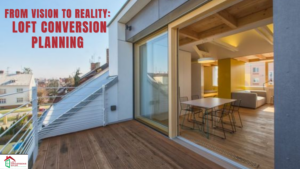Are you looking for a way to transform your attic? Would you love an incredible loft conversion
that can instantly add value and comfort to your home? Look no further!
This guide will provide all the tips and tricks needed to create a stunning, unique loft conversion
in the UK. With this knowledge, you’ll be able to craft a remarkable space that’s sure to turn
heads and leave guests talking about it long after they’ve left.
You won’t just transform your attic into something functional but also create a beautiful
sanctuary to relax and feel truly at home. So what are you waiting for?
Let’s get started on turning your dreams into reality!
Advantages Of Loft Conversions
Loft conversions can add incredible value to your home, giving you extra space and improving
the overall look of your property.
Opting for a loft conversion is an excellent way of maximising unused space in your attic,
making it more practical and comfortable.
Opting for a loft conversion is an excellent way of maximising unused space in your attic,
making it more practical and comfortable.
Ventilation solutions must also be considered, ensuring the area is correctly insulated while not
compromising breathability.
When done right, a loft conversion can give you much more than just an extra bedroom or office
– it can transform your house inside and out!
So don’t let those empty spaces go to waste; with careful planning and consideration of all
aspects, their potential can be unlocked to create something exceptional.
Designing Your Loft Conversion
It’s like taking a blank canvas and creating your masterpiece. Loft conversions offer the chance
for homeowners to make their attic into something that suits their individual needs – whether it’s
an extra bedroom, office or storage space.
To help you turn your loft conversion dreams into reality, here are some DIY tips:
- Start by drawing up a plan of what you want from your new room and consider how this will
impact existing spaces in the house;
- Research different flooring options available that fit within your budget and look at the insulation
materials designed to keep the room warm during winter months;
- Look at various storage solutions to ensure you can maximise every inch of space and
determine which lighting design would be best suited to the layout;
- Finally, determine if planning permission is required before proceeding with any work.
Transforming an attic takes time, patience and dedication but can enhance daily living. So, with
With these guidelines in mind, embark on your journey towards turning your dream loft conversion
into a reality!
Planning Permission And Building Regulations
Transforming your attic into a loft conversion can be exciting, but ensuring the project meets
local Building Regulations and planning permission requirements are crucial.
Seeking advice from qualified professionals will ensure that you comply with all regulations and
fully understand any environmental impact of the planned works.
When considering transforming your attic, you should always contact your local authority, who
will guide you on what permissions may be required for the work.
It’s also valuable to get budget estimates from professional contractors before starting any major
work – this way, you can plan and know precisely how much money needs to be set aside.
Whether converting attics or other parts of a property, always use experts with experience
building projects like these.
Experienced contractors will have access to quality materials and resources, which could save
time and money and avoid potential problems caused by a lack of knowledge or substandard
materials.
Cost Of Loft Conversion
Getting a loft conversion is an excellent way to increase your property’s value and create more
space. But it comes at a cost, so let’s look into the financial aspects of this work.
Firstly, many different options are available for budgeting for a loft conversion. So it might be
worth considering doing some cost-benefit analysis before you start any significant work – think
about what potential returns can be expected from the extra living area created by the converted
attic in terms of rental income or resale prices, for example.
Investing in clever storage solutions such as built-in wardrobes and cupboards will help ensure
that every inch of usable space is taken advantage of when adding extra room without taking up
too much floor space.
There are also plenty of ways to reduce energy consumption with insulation options like foam
boards or other materials while keeping within your budget.
Considering all these points during the planning stage, you should have no problem creating a
the comfortable living area and increasing your home’s market value!
Aftercare And Maintenance
As a UK building contractor, I’m here to tell you that your loft conversion is the most critical
project in town! The potential it has for transforming your attic into something extraordinary is
limitless.
From damp proofing and insulation tips to noise reduction and ventilation solutions – not to
mention the safety checks – this transformation will make your dreams come true.
The process can be daunting at first, but with our help, you’ll soon see why investing in a loft
conversion was one of the best decisions you have ever made. With every step we take
together, we guarantee satisfaction: from planning out each detail at the start to completion and
beyond.
And when it’s time for a check-up or maintenance? We’ve got you covered there too! We
understand how much effort goes into such an undertaking, so rest assured that aftercare and
maintenance is just as vital as any other aspect during transformation.
We pride ourselves on providing top-quality customer service, which means regular visits to
inspect your property and identify if anything needs updating according to changes in
regulations or trends. As a result, your new attic space should look its best – always!
Frequently Asked Questions
How Long Does A Loft Conversion Typically Take To Complete?
Regarding loft conversions, UK homeowners must consider planning permission, local laws and
budgeting for costs before they even begin.
But how long does a typical conversion take?
Well, depending on the scale of your project, you can usually expect the work to be completed
within 8-10 weeks – but this is only an estimate!
All finishing touches must be carried out with energy efficiency to ensure maximum comfort
throughout every corner of your home.
Does A Loft Conversion Increase The Value Of My Property?
A loft conversion can provide a great return on investment, adding value to your property and
making it more desirable to potential buyers.
As an experienced UK building contractor, we know that the key to ensuring maximum returns
lies in getting the details right – damp proofing, energy efficiency, natural lighting, ventilation
systems and flooring options should all be considered for optimum results.
With careful planning and execution of these elements with due consideration for local
regulations and permits, you can rest assured that your loft conversion will bring immensely
benefits not just financially but also aesthetically.
What Type Of Insulation Should I Use For My Loft Conversion?
Surprisingly, there’s more to loft conversions than just flooring options and access points.
Insulation is crucial to any successful conversion – yet it can be easily overlooked in the
excitement!
Whether you’re looking for insulation that maximises energy efficiency or keeps noise levels
down, we’ve covered all your ventilation needs, soundproofing techniques, and other
considerations.
Join us here at UK Building Contractor as we explore how best to insulate your new attic space
to ensure optimum comfort and style.
Are There Any Structural Requirements I Should Be Aware Of When Converting My Loft?
When converting your loft, you must be aware of specific structural requirements.
- Firstly, ventilation is essential for air quality and energy efficiency, so ensuring adequate circulation in the space.
- Secondly, obtaining planning permission may be necessary depending on where you live -check with your local council for advice.
- Thirdly, you’ll also need access to the roof inside the house – either a staircase or ladder will do.
- Fourthly, soundproofing can help reduce noise pollution and maintain privacy between floors.
- Lastly, consider using double-glazing windows or insulated skylights to provide extra warmth and comfort while saving money on heating bills too!
All these points should be considered when considering a loft conversion – good luck with yours!
Is There An Alternative To A Full Loft Conversion That Would Still Provide Extra Space?
Are you looking for a way to expand your home without needing a complete loft conversion?
You’re in luck!
Many DIY options don’t require planning permission or complex building regulations. But before
you start, it’s essential to keep safety features and room design front of mind so you can create
an additional space that suits your needs perfectly – all while keeping your family safe from
harm.
So let’s explore some creative ideas on transforming your attic with alternative solutions and
ensure everything meets legal requirements too!
So let’s explore some creative ideas on transforming your attic with alternative solutions and
ensure everything meets legal requirements too!
So let’s explore some creative ideas on transforming your attic with alternative solutions and
ensure everything meets legal requirements too!
Alternatively, you can opt for an attic renovation offering a more cost-effective solution without
compromising quality or comfort.
The key is to visualise what works best for you regarding functionality and aesthetics – consider
it is painting a picture with bricks and mortar that will transform your home into something
extraordinary.


